The “What’s New” document for Solaris 10 8/07 states the update “..includes the tools necessary to install a CentOS 3.5 to 3.8 or Red Hat Enterprise Linux 3.5 to 3.8 inside a non-global zone. Machines running the Solaris OS in either 32-bit or 64-bit mode can execute 32-bit Linux applications.” Additionally, “DTrace can now be used in a non-global zone..” and ZFS gets even cooler. w00t.
Author: preston.lee
-
Solaris 10 x64: Get Your Sound Card Working
When I built the $1000, 2TB file server, the on-board nVidia HD audio support of the Asus M2NPV-VM motherboard didn’t work out of the box. It’s a trivial fix using the recently open sourced OSS drivers from 4Front Technologies. (I also tested a Creative Audigy 2 PCI sound card using these drivers under Solaris 10 11/06, and the playback worked just as well.)
- Download the Solaris x64 .pkg.
- `pkgadd -d oss-solaris-v4.0-1004-i386.pkg`
- `osstest`. You should here the sweet sweet sound of.. umm.. sound, and the following printed on the console..
bash-3.00$ osstest
Sound subsystem and version: OSS 4.0 (build 1004/200707062145) (0x00040002)
Platform: SunOS/i86pc 5.10 Generic_118855-33*** Scanning sound adapter #-1 ***
/dev/oss/hdaudio0/pcm0 (audio engine 0): nVidia HD Audio play-front output
Note! Device is in use (by PID 0/VMIX) but will try anyway
– Performing audio playback test…
OK OK OK
/dev/oss/hdaudio0/pcm1 (audio engine 1): nVidia HD Audio play-side output
– Performing audio playback test…
OK OK OK
/dev/oss/hdaudio0/pcm2 (audio engine 2): nVidia HD Audio play-center/LFE output
– Performing audio playback test…
OK OK OK
/dev/oss/hdaudio0/spdout0 (audio engine 3): nVidia HD Audio spdif output
– Performing audio playback test…
OK OK OK
/dev/oss/hdaudio0/pcmin0 (audio engine 4): nVidia HD Audio record input
– Skipping input only device*** All tests completed OK ***
-
OpenSolaris ZFS vs. Linux ext3 RAID5
Preston Says: I asked Dan McClary for a big favor recently: use his general UNIX knowledge and graduate-level statistics voodoo to produce a report highlighting performance characteristic differencess between OpenSolaris ZFS and Linux RAID5 on a common, COTS hardware platform. The following analysis is his work, reformatted to fit your screen. You may download the PDF, HTML, graphs and original TeX source here.
A Brief Comparison of I/O Performance for RAIDZ1 and RAID-5 Filesystems
Dan McClary
June 28, 2007Introduction
The following is a description of results obtained benchmarking I/O performance for two OS/filesystem combinations running identical hardware. The hardware used in the tests is as follows:
- Motherboard: Asus M2NPV-VM.
- CPU: AMD Athlon 64 X2 4800+ Dual Core Processor. 2.5GHz, 2?512KB, 1GHz Bus
- Memory: 4 x 1GB via OCZ OCZ2G8002GK DDR2-800 PC2-6400
- Drives: 4 x 500GB Western Digital Caviar SE 16 WD5000AAKS 7200RPM 16MB Cache SATA 3.0Gb/s
The Linux/RAID-5 combination uses a stock Ubuntu Server Edition installation, running kernel 2.6.19-generic, with RAID-5 configured via mdadm and formatted ext3. The Solaris/RAID-Z1 configuration is a stock installation of Solaris Developer Express Edition with zpool managing the zfs-formatted RAID-Z1 drives. Block size for all relevant tests is 4096 bytes.
Basic I/O testing is conducted using bonnie++ (version 1.03a), tiobench (version 0.3.3-5), and a series of BASH-scripted operations. Tests focus on I/O throughput and CPU usage for operations either much larger than available memory, and very large numbers of operations on small files. All figures, unless otherwise noted, chart mean performance with 2% deviation for large-file operations and 5% for small-file operations. These bounds well-exceed the 95% confidence interval, implying a range of high significance.
Large-File Operations
In dealing sequential reads and writes, particularly of large files, the Solaris/RAID-Z1 configuration displays much higher throughput than the Ubuntu/RAID-5 combination. Latency and CPU usage, however, appear to be higher than in the Ubuntu configuration. The reasons for these disparities are not determinable from the tests concluded, though one might venture that the management algorithm used by ZFS and each systems caching policies may play a part.

Figures 1, 2, and 3 summarize large-file writing performance in the bonnie++ suite. In large writes, Solaris-ZFS displays marginally higher throughput and occasionally lower CPU usage. However, the disparities are not great enough to make a strict recommendation based solely on large-file writing performance.
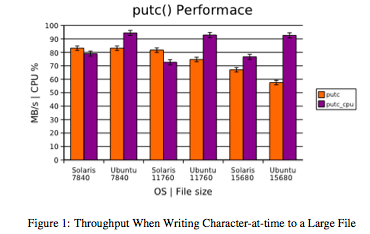
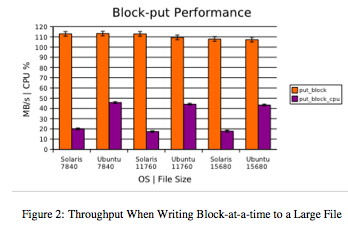
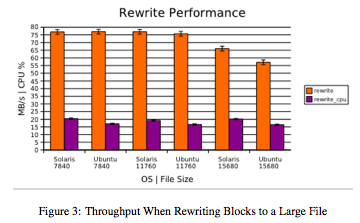

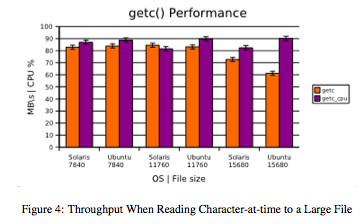
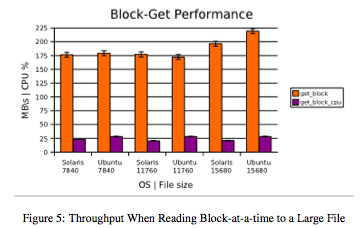
Figures 4 and 5 illustrate throughput and CPU usage while reading large files in the bonnie++ suite. Generally, results are consistent between platforms, with the Ubuntu configuration showing a slight edge when reading 15,680MB files (though with an associated drop in CPU efficiency).
tiobench results for random reads and writes given in Tables 3 and 4 show the Ubuntu/RAID-5 configuration displaying both higher throughput and greater CPU efficiency. However, these results seem somewhat questionable given the results in section §3.


Small-File Operations
In examining the performance of both configurations on small files, both in the bonnie++ suite and from shell-executed commands, the most obvious statement that can be made is that the Solaris configuration displays greater CPU usage. This, though, may not be indicative of poor performance. Instead, it may be the result of an aggressive caching or other kernel-level policies. A more detailed study would be required to determine both the causes and effects of this result. In each test, 102,400 files of either 8 or 4KB were created.
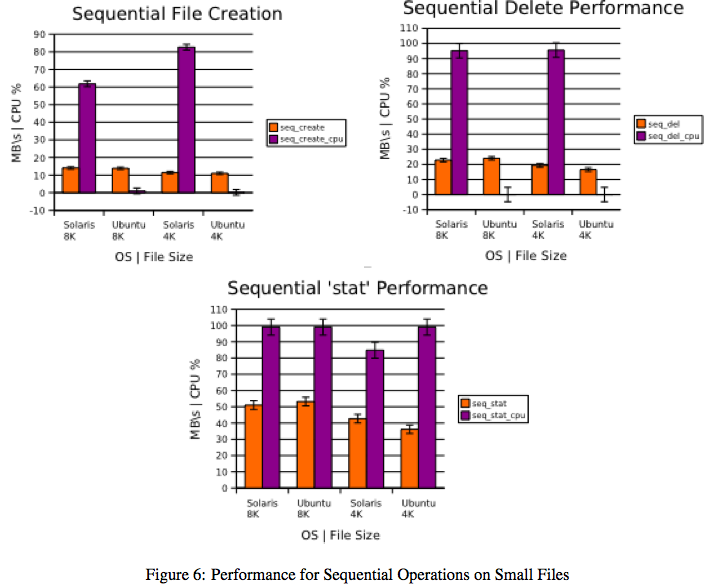
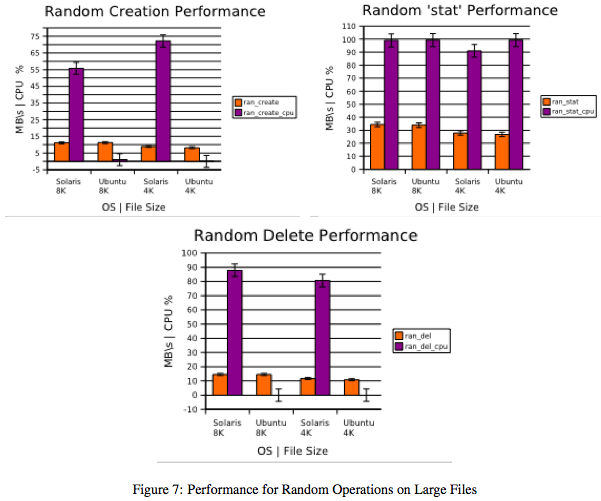
Figures 6(a)-6(c) and 7(a)-7(c) illustrate bonnie++ performance for both configurations. In contrast to the tiobench results, the Solaris configuration generally displays slightly higher throughput (on the order of 1-2MB/s) than its counterpart. However, as previously noted, CPU usage is much higher.
Finally, Tables 5-6 lists measured times as given by the standard Unix command time when measuring command execution. In these results, there are some surprises. The Ubuntu configuration performs somewhat faster when executing a large write (using the command dd). However, the Solaris configuration is much faster when dealing with 100,000 sequential 8KB files. For reference, all file creation is done via dd, copying by cp and deletion by rm.

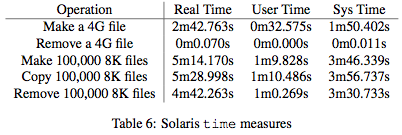
Conclusions
Few overarching conclusions can be drawn from the limited results of this study. Certainly, there are situations in which the Solaris/RAID-Z1 configuration appears to outperform the Ubuntu/RAID-5 configuration. Many questions remain regarding the large discrepancy in CPU usage for small-file operations. Likewise, the Ubuntu/RAID-5 configuration appears to perform slightly better in certain situations, though not overwhelmingly so. At best, under these default configurations, one can say that overall the Solaris configuration performs no worse, and indicates that it might perform better under live operating conditions. The latter, though, is largely speculation.
Indeed, from the analyst’s point of view, both configurations show reasonable performance. The desire to deploy either configuration in an enterprise setting suggests that significant-factor studies and robust parameter designs be conducted on, if not both candidates, whichever is most likely to be deployed. These studies would provide insight into why the discrepancies in current study exist, and more importantly, achieve optimized performance in the presences of significant uncontrollable factors (e.g. variable request-load).
Preston Says: Thanks for the outstanding work, Dan!
-
Programming Erlang Now Shipping, v1.1 PDF Released
The Pragmattic Programmers are now shipping print copies of Programming Erlang: an outstanding introduction to the interesting new Erlang language for concurrent programming. Peeps who bought the PDF can download v1.1 here.
-
Lala.com Review: Legal Web 2.0 Music Trading
 Lala.com is an online service for trading physical discs. After entering information on your current CD collection, what CDs you want, and receiving a free shipping kit of envelops and plastic disc carriers via postal mail, you simply start sending discs out as they are requested. Other users do the same, and the system handles the logistics and billing. You may start sending out CDs as soon as you receive the shipping kit to build trading credits, even if you do not yet have discs in your want list. Your credit card is automatically charged a total of $1.75 per CD you receive on a monthly basis.
Lala.com is an online service for trading physical discs. After entering information on your current CD collection, what CDs you want, and receiving a free shipping kit of envelops and plastic disc carriers via postal mail, you simply start sending discs out as they are requested. Other users do the same, and the system handles the logistics and billing. You may start sending out CDs as soon as you receive the shipping kit to build trading credits, even if you do not yet have discs in your want list. Your credit card is automatically charged a total of $1.75 per CD you receive on a monthly basis.I’ve been using it for months now and over 20 trades, and am pleased to report near complete success. On one occasion I did not receive a disc, but this was easy to report. I was never billed for the missing disc and never had to deal with the supposed sender personally. Overall I’ve had a pleasant experience and would recommend it to anyone looking to trade CDs with a minimum of hassle.
Props to lala for a great, legal idea!
-
Software Engineering Curse Words

Here lie terms frequently used in software development which I don’t particularly care for.
Programmer
Commercial software is as much about programming as building bridges is about installing steel I-beams. Writing actual code is only part of the engineering effort. When I see a job posting entitled “Java Programmer” I usually suspect that this is either (1) a low-level monkey position and/or (2) the person behind the post doesn’t really understand the scope of typical developer work.
Developers are required–much unlike the mechanical nature of an assembly line worker–to make decisions and assumptions about the external purpose and internal nature of their work, often part of a seemingly ingrokable ecosystem. Unless you have a micro managing boss or a heavy-weight process itemizing every last byte of work, you must personally exercise critical thinking, time management and interpersonal skills to balance your never ending stream of unclear and incompletely stated priorities. Being a successful programmer thus requires much more than programming knowledge.
The Point: The term “programmer” in an inaccurate trivialization of the real job. I prefer “Software Engineer” formally and “developer” in colloquial usage.
Senior
For HR purposes, “Senior” is a nice way of labeling someone as having a bit more knowledge, responsibility, general weight, and more income than a non-senior person. The problem is that both senior and non-senior developers tend to have very similar job duties; so aside from income, the criteria of senior personnel are inherently qualitative, subjective, relative to a particular domain (read: not necessarily guaranteed to transfer being projects), and/or effectively indistinguishable from non-senior status.
The effect is that, in a matrix organization, a new project may end up with n00bs who are senior, experts who are junior, and a pay structure which reflects an old project now completely irrelevant to the current situation. Senior and non-senior developers often work together as peers, and everybody quickly figures out who the real leaders are. And that’s frequently very different from the formal structure and correlating pay grade.
The Point: “Senior” tells me that you’re expecting to make more and are probably good at something, which may or may not be relevant to me. It’s not a global implication of elevated wisdom.
Architect
Most “software architects” I’ve met do far more operational and project management than architectural design work. This isn’t to say that they don’t or aren’t capable of making significant design contributions to the project, but that all the overhead of email and meetings between business/team/customer/whomever members sucks up so much time that lower level engineers have to either make the design decisions for the architect or block indefinitely as the architect plays Inbox-fu.
The Point: If you’re an “architect” who doesn’t have time to sit down with the engineers and talk about design, you’re really a technical manager who needs to officially delegate the design work to avoid becoming a bottleneck for the team.
Resource
I shudder whenever I hear or use this word, usually in a managerial, Mythical Man Monthian context trying to quantize everyone into tiny cube shaped units. I find it so important to account for individual character when planning and estimating that I consciously use the word “people” instead of “resources”; it’s a simple trick to force yourself into remembering the undeniable human individuality of the worker bee.
The Point: People aren’t Legos, so let’s not pretend they are.
-
20 Steps To Xen: A Quick Xen Tutorial For Ubuntu 7.04 x64 Server
This is an abbreviated and simplified version of a more official document. Run these either as root or with the “sudo” command..
- apt-get install ubuntu-xen-desktop-amd64 to install a new Xen kernel and various other tools. Apparently we’re supposed to use the “server” version instead, but it didn’t show up in the repository. Oh well.
- apt-get install debootstrap to install the “debootstrap” system bootstraping tool for you.
- reboot into the new kernel.
- xm list to make sure Domain-0 shows up. Domain-0 represents the host system.
- Edit /etc/xen/xend-config.sxp and uncomment “(network-script network-bridge)”. Also comment out “(network-script network-dummy)”.
- xend restart to restart the xen daemon.
- mkdir -p /xen/slave1 to create a mountpoint for the slave system disk.
- dd if=/dev/zero of=/xen/slave1.ext3 bs=1M count=512 to create a 512MB “disk” as a normal file.
- mkfs.ext3 /xen/slave1.ext3 to create a file system in said empty file.
- mount -o loop -t ext3 /xen/slave1.ext3 /xen/slave1 to manually mount the new filesystem to its mount point.
- debootstrap –arch amd64 edgy /xen/slave1 to install a bare bones edgy system onto the new file system.
- cp -a /lib/modules/2.6.19-4-generic-amd64/ /xen/slave1/lib/modules/ to install the hosts kernel modules into the new system.
- Edit /xen/slave1/etc/network/interfaces. It should look similar to..auto lo
iface lo inet loopbackauto eth0
iface eth0 inet static
gateway 192.168.1.110
address 192.168.1.111
netmask 255.255.255.0..where “gateway” is the host machines IP address, and “address” is a unique IP address for the slave machine.
- Update /xen/slave1/etc/hostname with whatever you want its host name to be.
- Update /xen/slave1/etc/hosts with all your IP addresses.
- Update /xen/slave1/etc/fstab to mount stuff on boot, like so..proc /proc proc defaults 0 0
/dev/hda1 / ext3 defaults,errors=remount-ro 0 1 - umount /xen/slave1 to unmount the file system.
- Create /etc/xen/edgy-guest.cfg to configure the host to start the guest, like so..
kernel = “/boot/vmlinuz-2.6.19-4-generic-amd64”
ramdisk = “/boot/initrd.img-2.6.19-4-generic-amd64”
builder=’linux’
memory = 512
name = “edgy-slave1”
vcpus = 1
vif = [ ‘bridge=xenbr0’ ]
disk = [ ‘file:/xen/slave1.ext3,ioemu:hda1,w’ ]
root = “/dev/hda1 ro” - xm create slave1-edgy.cfg to create and start the new domain.
- xm console slave1-edgy to establish a console to the new domain. (Hit CTRL+] to exit.)
You should now be able to log in via the xm console as root, and ping the guest on 192.168.1.111 (or whatever its IP address is). w00t!
-
The $1,000 (USD), 2TB OpenSolaris File Server

Here’s how to score a sweet OpenSolaris-compatible 2TB file server for $1000 (USD). I’m running Solaris Express Developer Edition on it with a ZFS RAIDZ1 file system.
- Motherboard: Asus M2NPV-VM. A great, inexpensive mATX board w/4 SATA ports, 2 IDE, PCI-X, GigE, built-in nVidia graphics w/DVI and VGA outs, FireWire, and tons of USB love. Oh, and the official nVidia driver works like a charm. Sweet! (The only thing that hasn’t run out-of-the-box is the built-in audio controller. Oh well.) $100.
- CPU: AMD Athlon 64 X2 4800+ Dual Core Processor. 2.5GHz, 2x512KB, 1GHz Bus. $130.
- Memory: 4x1GB via OCZ OCZ2G8002GK DDR2-800 PC2-6400 kits. $175 total (after MIR).
- Drives: 4x500GB Western Digital Caviar SE 16 WD5000AAKS 7200RPM 16MB Cache SATA 3.0Gb/s for the ZFS data volume. $450. (Old, small, slow and cheap PATA disks reused for the system volume. FMV ~$25.)
- Optical Drive: Reused old typical IDE DVD-ROM. FMV ~$20.
- Case: Reused typical ATX tower w/450 watt PSU. FMV ~$80.
- Peripherals: Reused optical mouse and keyboard. FMV ~$20.
Total: $1,000. Nice!
-
RailsConf 2007 Photocast
Me and a couple thousand other Rails users are chillin’ in Portland right now enjoying the wifi. Here’s my photocast of things related to RailsConf and Portland, which I’ll update each night.
